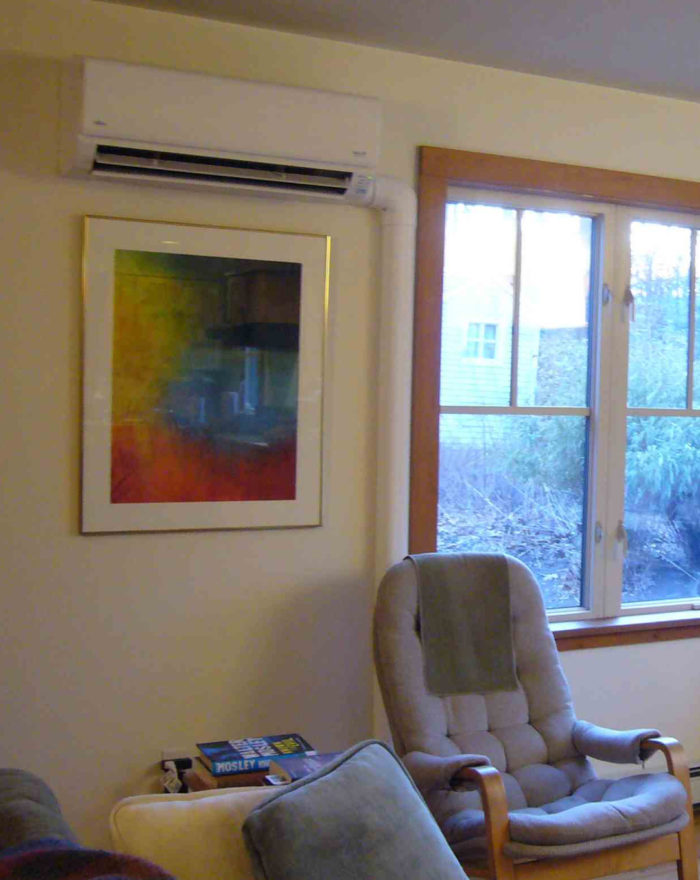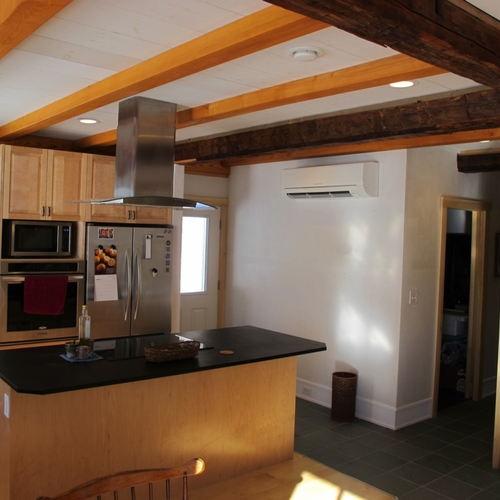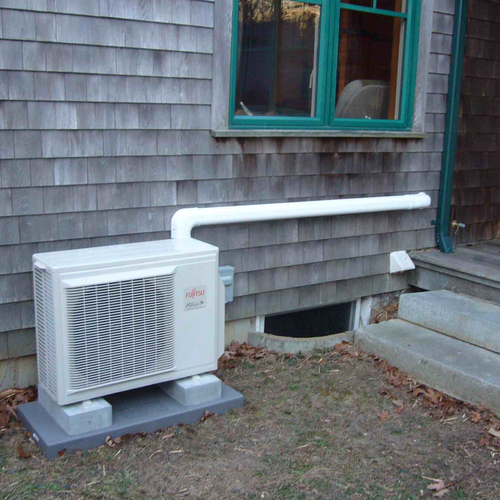
Image Credit: Marc Rosenbaum
When we yanked the oil boiler, we replaced it with a wall-mounted minisplit heat pump in the main level open area that includes kitchen, dining, living and our little office area. We closed off the first-floor bedroom and bathroom so those rooms are only heated by conduction and air leakage through the walls, and so they get cold — in the high 40°Fs at the lowest last winter.
The second-floor bedrooms and bathroom are only heated by warm air from the main floor rising up as cooler air from upstairs drops. This is a natural convection cycle, and it works pretty good and for free! Dontcha love physics?
Monitoring indoor temperatures
I’m data-logging temperatures in the basement, main level, upstairs, and outdoors with Hobo data loggers. The data for a week in December 2011 is shown in the graph below.
The outdoor temperature dropped as low as about 16°F and climbed as high as 57°F. The upstairs ran 2 to 4 F° cooler than the main level, except when it was good and sunny and it heated up with more unshaded south glazing per square foot of floor area than the main level.
December 26th was the only good sunny day in the six days shown in the graph, and you can see where the upstairs temperature climbs above the main floor temperature briefly.
We set the heat pump thermostat to 70°F when we’re here and to 66°F when we are asleep or gone. This being Christmas week, we were here a good bit more than usual, since both of us have been off of work since the end of day on the 23rd, which is the first full day of this series shown above.
If one of us were to be working at home upstairs, we’d need some supplemental heat — probably an electric radiant panel, like the ones we put into the Eliakim’s Way homes that I wrote about here. A panel like this heats up quickly and can be located so that it heats a person in a fixed location, like a desk, directly. It’s a good supplemental heat source for a house with a point-source heat pump.
Does our ductless minisplit system need more indoor units?
Of course, we could also install more heat pump cassettes. In the most extensive case, there would be four: the one we have and one in each of the three bedrooms.
I think if we ever use the first-floor bedroom, we might install another Fujitsu single zone unit for that room — albeit the 9,000 BTU/hour model rather than the 12,000 BTU/hour unit we have now, because it’s a smaller space. Then we’d add the radiant panels in the upstairs bedrooms as well, which we may do at some point as I have two of them laying around in the basement!
But for our present use of the house, the point-source system works well, and was inexpensive way to get off of fossil fuels and let the PV system supply the energy we use for heating (albeit on an annual basis…)
A year’s worth of monitoring data
We just passed our first year using the Fujitsu 12RLS for heating, with the exception of a 7 1/2 day period in early February 2012 when I switched back to the oil boiler to get some data, which was equal to about 5% of the heating degree days (HDD) in this one-year period. The heat pump energy consumption at the meter was 1,366 kWh; adding the missing 5% brings the consumption up to about 1,441 kWh/year.
I don’t know if that is the full number, as we have learned that electromechanical meters don’t always pick up the low wattage periods of consumption. The heat pump was off at the breaker for close to 6 months (May to October).
This works out to about 0.28 kWh/HDD. We keep the first-floor bedroom and bath closed off and they only are heated by conduction through the walls. The remaining area (gross square feet) of the house is about 1,300. So space heating energy use is about 0.73 BTU/sf/HDD in terms of input energy.
If the Fujitsu is operating at an overall COP of 3, then heating demand is about 2.2 BTU/sf/HDD, which is believable — a little lower than I’d expect, but we don’t keep it at 70°F unless we’re there and awake (70°F under those conditions, 66°F otherwise).
I’ve got Hobo data loggers set up now, logging temperatures on the main floor where the heat pump is, the bedroom upstairs, the basement, and outdoors, so I’ll have a better idea of performance as we move through the winter. Overall, we’re very pleased with this gizmo. I think we’ve paid about 1/4 the cost of what we would have if we’d used the oil boiler instead.
Marc Rosenbaum is director of engineering at South Mountain Company on the island of Martha’s Vineyard in Massachusetts. He writes a blog called Thriving on Low Carbon. Marc teaches a 10-week online Zero Net Energy Home Design course as part of NESEA’s Building Energy Master Series. You can test drive his class for free.
Weekly Newsletter
Get building science and energy efficiency advice, plus special offers, in your inbox.
















8 Comments
Can the convection cycle be improved?
Marc, you mention the natural convection cycle of warm air rising to the second floor and cold air falling to the first floor - I have point source heat (wood stove) on the main floor and would like it if more heat got to the upper rooms. I'm considering cutting holes between the floors in hopes of encouraging more air circulation - do you think small floor vents can help improve the convection cycle and spread the heat more evenly throughout a house?
Thanks for the help
Standby Loads
Hi Mark,
Great blogs! Lots of information! Thanks for sharing!
I had a couple of follow-up questions:
1) What equipment are you using to measure 240V appliances? I'd like to monitor some of my 240V loads, but there are so many different connections . . . hardwired to panel (like the minisplit), NEMA 14-30R (water heater and clothes dryer), and NEMA 14-50R (kitchen range).
2) Have you measured the standby load for the minisplit? I have a 9,000 Btu Mr. Slim model, and I was wondering how much electricity it is using:
* When it's turned off on the remote, but still powered at the breaker panel
* When the compressor is off, but the inside fan unit is still running (no load conditions)
I noticed that you turned the heat pump off at the breaker. So I'm guessing that you measured the standby load and you were trying to save electricity . . . ?
Thanks again!
Superinsulation is the Key to Comfort
It's pretty obvious, but a point source for heat works significantly better if :
1. Interior doors are left open when appropriate.
2. Air infiltration is minimized from outdoors.
3. The walls are insulated to R30 or higher.
What model Hobo data logger?
What model of Hobo data logger and sensors do you use?
I am looking for an inexpensive temp logger for capturing temperatures in various parts of the house and outside.
Mark it can help
Growing up in southern Ohio our primary heat source was a wood/coal burning stove located in the living room on the first floor level. Directly over that was a floor vent into one of the two bedrooms on the second floor level. This vent was so effective that a rug was usually placed over the vent to prevent ALL the heat from the stove going directly to the second floor!
Response to Mike Strevell
Mike,
Information about Hobo data loggers is readily available on the Onset website. (Onset is the manufacturer of Hobo data loggers.)
Hobo temperature loggers start at $65.
Calculating btu/sf/hdd
Marc, I'm curious if I did my math right. Is your HDD value 5,146? If so, are you counting HDD that the ASHP was not consuming power? Like for days you turned the unit off. And what base temperature are you using to get HDD? You said you keep the heat at 70 or 64.
I have an eMonitor and hobo monitors. I'm tracking the ASHP circuit so I know how much the ASHP is using and when. I'm trying to use the same math to determine our btu/sf/hdd. I don't have a full year's worth of data yet.
So if I only sum the HDD that the ASHP was operating, I get .34 btu/sf/hdd. But that uses a much smaller number of HDD (605). We've only used the ASHP for a total of 28 days between March 16 and Oct 31. I use 68 as a base temperature to calculate HDD. Our gross area is 1408. We used 84.99 kWh for the ASHP in that time period.
Am I on the right track? Thanks and great article!
RE: Thermosiphon Effect
Marc,
I realize that your home is much more air tight and insulated than mine, however I am also using a heating system primarily in the first floor to also provide heat (via thermosiphon) to the second floor. In my experience it does work, but not well. The rate of flow is generally too low to provide consistent temperatures between floors. I'm guessing that only a low-capacity, constant-flow vented ventilation system connecting all rooms is the sure cure. Worse, the air flowing up/down between floors impacts comfort in a negative way similar to eddy currents formed in 2-story great rooms. We humans really do not like air movement next to our skin - unless the moving air (or our core temp) is VERY warm.
Log in or create an account to post a comment.
Sign up Log in